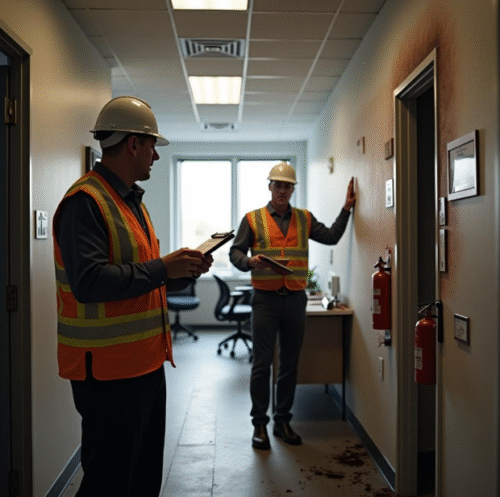The tabletop is your first impression
October 16, 2025GMB Suspended: Restoring Business Finances After a Google Profile Suspension
October 16, 2025
Fire safety in the workplace is one of those things we rarely think about until a real emergency puts it into sharp focus. Yet, businesses across the UK are legally and morally bound to take it seriously.
Not only do fires wreck property, but they also cause disruptions to businesses and people. That’s why having the right workplace fire safety strategies UK organisations can depend on is not optional, it’s essential.
Why Fire Safety Should Be a Top Business Priority
Every workplace, from offices in London to factories in Manchester, faces fire risks. Electrical faults, overloaded sockets, poorly stored materials, or simply human error can trigger a blaze in seconds.
With the potential for loss of life and huge financial costs, the drive to improve fire safety at work cannot be understated.
In the UK, legislation like the Regulatory Reform (Fire Safety) Order 2005 makes it a business duty to ensure premises are safe.
That means every employer, manager, or building owner must put workplace fire prevention measures in place. If this isn’t done, there could be fines, harm to one’s image, and worse, lives lost.
Building a Strong Fire Safety Culture
Fire safety isn’t just about installing alarms or hanging up extinguishers. It is about having an atmosphere in which every employee makes an effort for fire safety. With strong fire safety management UK businesses can make safety second nature. Employees must be aware of how to prevent hazards, as well as what is to be done in an emergency.
When teams talk about safety openly, and managers lead by example, small actions add up. A culture of awareness keeps fire risks visible, and that vigilance is often what prevents disasters before they happen.
Investing in Training for Staff
Even the best policies mean little without staff who know how to put them into practice. That’s why employee fire safety training UK businesses provide should go beyond tick-box exercises.
Workers should understand evacuation procedures, how to use extinguishers properly, and how to recognise hazards before they escalate.
Regular drills, clear signage, and hands-on sessions give staff the confidence to act calmly if an alarm ever sounds. Well-trained employees turn into your first line of defense, ensuring that workplace fire risk reduction is not just theory but lived reality.
Smarter Office Fire Safety Practices
Offices may seem low-risk compared to industrial sites, but fires in offices are more common than many realise.
Overloaded plug sockets, poorly maintained electrical equipment, and even clutter blocking fire exits are frequent culprits. That’s why office fire safety tips UK employers can implement make such a difference.
Simple steps like unplugging equipment after hours, carrying out Portable Appliance Testing (PAT), and keeping escape routes clear reduce hazards significantly.
Combined with regular checks on extinguishers and alarms, these measures create safer workspaces where risks don’t go unnoticed.
Planning Ahead for Emergencies
No workplace can ever be declared 100% risk-free. But with thorough fire safety planning for businesses, the impact of an emergency can be controlled.
This means having evacuation routes clearly marked, assembly points known to everyone, and responsibilities assigned to fire wardens.
It’s not enough to have a plan filed away in a drawer. Plans must be reviewed, updated, and rehearsed. A dusty binder won’t save lives, but well-practised procedures will.
When it comes to workplace fire prevention measures, this pragmatic approach might be the difference between pandemonium and serenity.
Policies That Make Safety Practical

Policies shouldn’t be confusing, overly technical, or ignored. Fire safety policies for offices should instead provide straightforward guidance that employees can easily follow.
Clear rules around the safe use of appliances, proper storage of flammable items, and the reporting of hazards create consistency across the board.
When policies are realistic and tailored to the type of business, they’re far more effective. For instance, the fire risks in a commercial kitchen and a tech office in Birmingham are significantly different. Consulting a UK fire risk surveyor can help ensure these policies align with real-world risks and legal standards.
Aligning rules with actual risks is how fire safety management UK regulations are brought to life in practice.
Technology and Smarter Systems
Modern businesses benefit from technology designed to keep workplaces safe. From advanced alarm systems that detect smoke faster to sprinkler systems that limit damage, commercial fire safety best practices UK companies use today are far more sophisticated than in the past.
Smart monitoring systems can link directly to emergency services, while digital fire logbooks make record-keeping more accurate.
Combining traditional vigilance with modern tools brings workplace fire risk reduction to the next level. It’s about prevention, but also fast response when prevention fails.
Linking Prevention to Business Continuity
Fires don’t just threaten lives; they disrupt operations and profits. That’s why fire prevention strategies for businesses should always be part of wider continuity planning. A serious incident can force closures, damage customer trust, and even end smaller companies.
Integrating fire safety into continuity plans means having backups for data, insurance in order, and suppliers ready to step in if facilities are temporarily lost.
Protecting people is the top priority, but protecting the future of the business is the next logical step. Both depend on fire prevention measures being taken seriously at every level.
The Role of Leadership in Safety
The best approach to guarantee fire safety is to lead from the top. Leaders who invest in training, inspections, and modern equipment show staff that safety isn’t negotiable.
When management demonstrates commitment, employees follow suit. This is where workplace fire safety strategies UK businesses adopt must start, at the leadership level.
Fires don’t announce themselves, but leaders can prepare their people, their buildings, and their systems. Safety isn’t just a compliance task. It’s a leadership responsibility that protects employees, assets, and reputations all at once.
Regular Risk Assessments and Legal Compliance
One of the cornerstones of fire safety in the UK is the requirement for ongoing risk assessments. These aren’t just paperwork exercises, they’re the bedrock of effective fire prevention.
By systematically inspecting the workplace for hazards, businesses can address issues before they turn dangerous.
Under UK legislation, all employers are required to conduct hazard assessments, and fire is a very common hazard. These reviews should cover electrical systems, flammable materials, exit accessibility, and the effectiveness of alarms and sprinklers.
Ignoring these obligations puts people in danger and leaves companies exposed to hefty fines. That’s why fire safety management UK standards place such heavy emphasis on them.
But risk assessments must be living documents, not one-off projects. They should be reviewed after any workplace change, like an office move or installation of new equipment.
Continuous improvement means safety adapts to the evolving nature of workspaces, ensuring fire prevention strategies for businesses remain robust.
Tailoring Safety for Different Industries
No two industries face the same risks, which is why workplace fire prevention measures need tailoring.
An office tower in London and a warehouse in Leeds will have entirely different fire profiles, which makes conducting a United Kingdom’s fire risk assessment essential for identifying potential hazards specific to each environment. Implementing pertinent and successful solutions requires an understanding of these subtleties.
For offices, simple practices like regular electrical testing, proper storage of cleaning products, and clear escape routes form the backbone of office fire safety tips UK employers rely on.
In contrast, manufacturing plants must address machinery sparks, combustible dust, and large volumes of packaging waste.
Commercial fire safety best practices UK regulators highlight are only effective if they match the environment. Although generic regulations may appear to be compliant on paper, they may not be followed in practice. Industry-specific adjustments are the real key to workplace fire risk reduction.
Communication and Awareness Campaigns
Even the best plans fall short if employees aren’t aware of them. Regular communication keeps fire safety top of mind and helps embed a culture of responsibility. Posters, digital reminders, and short refresher sessions all ensure staff stay aware of both risks and responses.
A business may invest in advanced alarm systems, but if employees panic during an evacuation, the system hasn’t truly worked. Awareness campaigns bridge this gap.
By reinforcing knowledge and reminding workers about fire safety policies for offices, organisations create smoother, safer responses when every second counts.
This communication should also include feedback mechanisms. Employees often notice hazards managers miss, like blocked fire exits or broken extinguishers. By providing a simple means for employees to voice concerns, fire safety becomes a collective obligation.
Outsourcing Professional Support
Sometimes businesses lack the expertise to manage fire safety in-house. In this situation, expert consultants are invaluable.
Specialists can carry out detailed assessments, deliver tailored employee fire safety training UK organisations benefit from, and ensure compliance with the latest standards.
External support is particularly valuable for smaller businesses, where internal resources are limited. Outsourcing doesn’t remove responsibility, but it does provide confidence that workplace fire safety strategies UK regulations require are being met properly.
It also ensures the latest industry knowledge is applied, including changes to NFPA codes and UK guidance.
With expert help, companies gain not just compliance but peace of mind, knowing that prevention strategies are robust and up to date.
Embedding Fire Safety in Daily Operations
Never should fire safety seem like a one-time annual box-ticking exercise. It must be included into everyday activities.
This means keeping escape routes clear, checking equipment during regular maintenance, and encouraging workers to act immediately when hazards appear.
Embedding safety into day-to-day operations transforms policies into habits. When staff instinctively avoid overloading sockets, or supervisors automatically check exits at the end of the shift, workplace fire risk reduction becomes second nature.
Such constant, daily attention to detail is the sign of successful fire safety planning for businesses. It doesn’t rely on one-off events, but on small, repeated actions that build resilience over time.
Learning from Real Incidents
Case studies and real-world examples often highlight the consequences of poor planning. Across the UK, fires in commercial premises have made headlines for devastating losses. Better safeguards could have avoided a lot of these occurrences.
Sharing lessons from these events helps reinforce why fire prevention strategies for businesses are more than theoretical exercises. Employees relate to real outcomes, and managers see the tangible cost of negligence.
British companies can steer clear of committing similar errors by examining what went wrong in other places. It’s about turning hindsight into foresight, and using unfortunate events as powerful reminders of why fire safety policies for offices matter so deeply.
Fire Safety as Part of Sustainability

Businesses today are under pressure to safeguard the environment as well as people. Fire incidents release harmful pollutants, destroy resources, and create waste that contradicts sustainability goals. Linking safety with sustainability makes fire prevention even more relevant today.
For example, integrating eco-friendly suppression systems, using fire-resistant sustainable materials, and ensuring safe storage of lithium-ion batteries all align safety with environmental responsibility.
These approaches show that commercial fire safety best practices UK companies adopt can also support green agendas.
By viewing fire safety through this dual lens, protecting people and protecting the environment, businesses strengthen both their compliance and their corporate reputation.
Take Action with a Professional Fire Safety Risk Assessment
If you’re serious about protecting your workplace, a professional Fire Safety Risk Assessment is the smartest step forward.
It identifies the unique hazards in your premises, evaluates existing protections, and gives you a clear action plan to improve fire safety at work.
From spotting overlooked issues in your office to designing advanced prevention measures in industrial sites, professional risk assessments, such as those provided by firesafetyriskassessment.co.uk, give you the confidence that nothing has been left to chance.
Investing in one today is not just about compliance, it’s about safeguarding people, property, and the future of your business.
Conclusion
Fire safety is a continuous commitment rather than a box to be checked. From staff training and technology upgrades to clear policies and daily vigilance, every action matters.
By weaving safety into the fabric of your operations, you create a workplace that’s ready, resilient, and responsible.
Contact Us
Looking to strengthen your workplace fire safety strategies in the UK? Fire Safety Risk Assessment team is here to help. Whether you need expert advice, tailored employee fire safety or a full Fire Risk Assessment, your consultation is only a message away.
Get in touch now to talk about your requirements and start the process of creating workplaces throughout the UK that are safer, stronger, and more compliant.
